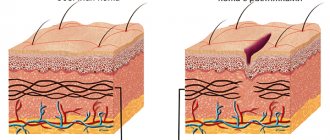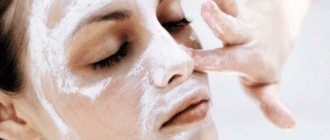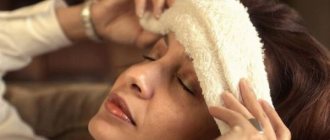How it works?
The desired effect is achieved by treating the skin with glycolic acid. This is a substance obtained from sugar cane and has the form of colorless crystals. In cosmetology it is used in dissolved form.
Glycolic acid allows you to remove dead, keratinized epidermis. Penetrating deep into the skin, it weakens the connection between the cells of its upper layer, resulting in exfoliation.
Another property of glycolic acid is the activation of renewal and restoration processes at the cellular level. After the destruction and removal of the upper particles of the epidermis, the regeneration of a new, healthier and cleaner layer of skin actually starts.
Visually, after the glycolic peeling procedure, wrinkles and scars become less noticeable, pigmentation decreases, the skin looks radiant and moisturized, and the complexion is evened out.
To achieve a sustainable result, you need to complete a full course consisting of 6-8 procedures.
Properties of glycolic peeling
Peeling based on glycolic acid has a gentle effect on the epidermis. The procedure triggers cellular regeneration, causing the skin to become fresh, smooth and rejuvenated. Glycolic acid works as follows:
- Improves blood circulation, promoting rapid skin restoration.
- The structure of sebaceous plugs is destroyed due to the action of A-HA acids. This helps get rid of common skin problems such as milia and comedones.
- Helps prevent hyperpigmentation by evenly distributing melanin.
- It has a rejuvenating effect at the cellular level by stopping the destructive processes of withering.
Glycolic acid is found in beets, sugar cane and grapes. It also brightens the skin and reduces the appearance of age spots and freckles.
Important! After using glycolic acid, you need to protect your skin from sunlight, otherwise the effect will be exactly the opposite.
Who is glycolic peeling recommended for?
In what cases does it make sense to perform glycolic peeling at home or in a salon? The procedure is indicated for a number of skin defects:
- increased pigmentation, freckles;
- enlarged pores, numerous “blackheads”;
- acne and its consequences (scars, scars, unevenness);
- aging and fading of the skin.
If there are no special reasons for peeling, but you want to try a new cosmetic product out of interest, it is better to abandon this idea. The acid has a powerful effect, thinning the skin. Subjecting her to such a load without good reason is irrational.
Contraindications to the procedure
Glycolic acid, if applied incorrectly, can damage the skin and cause undesirable consequences, so before peeling you need to study the list of contraindications.
The procedure cannot be performed if:
- You are pregnant;
- the surface of the skin is currently damaged (cuts, wounds, inflammation);
- you are undergoing or have recently completed a course of chemotherapy;
- there are warts on the face;
- less than two weeks have passed since visiting a solarium or actively tanning naturally;
- there are herpetic rashes on the area where peeling was applied;
- I was previously allergic to cosmetics with fruit acids.
- history of asthma, diabetes, cardiovascular pathologies.
Since it is difficult to avoid sunburn in the summer, peeling is best done in the fall, early spring or winter. If this condition is not met, the risk of irritated and discolored areas appearing on the skin increases.
How to do peeling at home?
Before the procedure, you need to prepare your facial skin. Also, even if you decide to do glycolic peeling at home, it is advisable to first visit a cosmetologist and consult about the optimal acid concentration in your case.
Preparation
Preparation means applying a cream or toner to the face containing a small amount (4-5%) of glycolic acid.
The product is used before bedtime, duration of use is 2-4 weeks. This will help gradually prepare the skin for the upcoming procedure and improve the final result.
To carry out glycolic peeling, you will need to purchase a number of cosmetics:
- lotion to remove excess sebum;
- glycolic acid of the selected concentration;
- neutralizer;
- moisturizing cream.
All of the above must be produced by one manufacturer. Such cosmetics are sold in specialized stores and pharmacies.
Choice of product
The result of the procedure largely depends on the concentration of acid in the peeling agent and its pH level. There is a considerable range of cosmetics containing 5-10%, 20-30% and 50-70% of the active substance.
The first group is more adapted for home use, penetrates the skin shallowly and eliminates only superficial defects. But it must be taken into account that in women over 50 years of age, peeling with a weak acid concentration may not give the desired result.
The second and third types of products are used in specialized salons and clinics. They give a pronounced result, but you should not use them without professional skills, there is a high risk of damaging the skin
As for pH, for independent use it is not recommended to choose cosmetics in which its level is below 3.5. The higher this indicator, the softer the peeling effect.
Peeling application
The procedure begins with cleansing the skin. You need to wash your face and wipe your face with a degreasing lotion. This is a necessary step because glycolic acid cannot properly penetrate the fatty film that protects the skin.
Then, over the entire face, with the exception of the surface of the eyelids and lips (there should be a clean space of 0.5 cm around them), a gel containing acid is distributed with a special brush.
Application begins from the forehead, then moves to the nose and cheeks, and lastly the chin.
The product is left on the skin for 3-5 minutes. Mild tingling and burning during this period is normal.
But if the sensations become unbearable or increasing swelling and redness appear, the procedure should be stopped immediately. Prolongation of the exposure period in this case is fraught with cicatricial changes in the skin.
Completing the procedure
Glycolic peeling at home is completed by washing off the acid. To do this, moisten a cotton pad with a pre-purchased neutralizer and gently wipe the skin.
After this, you need to wash your face with cool water and apply a moisturizing mask or cream. Subsequently, it is recommended to use restorative and softening cosmetics, and you should refrain from decorative cosmetics for the next 2-3 days.
Regular baby soap is suitable for washing during this period. If you have to be in the sun for two weeks after the procedure, you must use sunscreen.
As a rule, one application of glycolic acid is not enough, but the procedure can be repeated only after a week. A full course consists of an average of 6 procedures (sometimes more), after which you need to take a break for six months.
Features of glycolic peeling
Glycolic acid peeling is one of the types of procedures, the purpose of which is to influence the skin using chemical components. The main ingredient of the mask is glycolic acid. Thanks to the properties of the acid, the horny cells of the epidermis are exfoliated, the skin surface becomes smooth, pigmentation and keratinization are neutralized. Peeling helps to stop anti-inflammatory processes, stimulate the production of collagen, elastane, and glycosaminoglycans. As a result, after several sessions, a visible result is observed: the face looks younger, fresher, and smoother.
Glycolic acid is classified as a fruit acid obtained from plant materials. The largest amount of it is found in sugar cane. One of the main advantages of acid is the ability to absorb water and affect the process of removing dead cells from the epidermis. Glycolic acid is included in a number of cosmetic preparations, one of which is masks - peelings. Like any cosmetic product, it can cause allergies. Before use, you should definitely consult a cosmetologist.
Peels with glycolic acid are usually done in a salon. The concentration of acid in the mask may vary. It all depends on the purpose of use. The salon specialist himself determines the required dose.
Glycolic peeling is prescribed strictly during autumn and winter. In the spring and summer, due to the activation of the sun, procedures are highly undesirable. Under the influence of ultraviolet radiation, pigment spots may form. Before going outside, you have to protect your skin with a cream with high UV protection. To avoid this, it is better to cleanse your face during the cold season.
The procedure itself involves applying peeling for two minutes. A burning sensation is possible. The acid reaction is then neutralized using a special agent. Next, apply a nourishing mask for 30 minutes. Many women do not resort to this for fear of skin burns. In reality, the risk of getting burned is negligible. After cleansing your face, there will be slight redness and peeling on the skin. The defect goes away quickly.
Possible complications and precautions
The use of glycolic acid is often accompanied by side effects, the most common of which is swelling on the face. There is no need to worry about this, because they will go away on their own in a few hours.
If the procedure is unsuccessful, other undesirable effects may occur:
- Allergic reaction. If swelling of the face or difficulty breathing occurs, carefully remove the product and seek medical help. Glycol peeling cannot be performed in the future.
- Skin burn. Severe burning and the presence of reddened, swollen areas are a sign of damage to the epidermis. The face must be immediately cleaned of peeling, washed with cool water and lubricated with regenerating cream. If symptoms do not go away, you should visit a doctor.
- Increased dryness and flaking of the skin. You can eliminate the problem with the help of deeply moisturizing creams. It is not necessary to interrupt the course of procedures, but it is necessary to shorten the period of exposure to the acid on the skin.
The risk of complications after glycolic peeling can be minimized by following all application rules.
An allergic reaction is the most dangerous, so a sensitivity test to the product is performed before use.
To do this, apply a little glycolic acid gel, which you plan to use, to the crook of your elbow. It is left for 5-7 minutes and then washed off.
If there is a slight tingling or burning sensation, everything is fine, but if there is severe discomfort, redness and swelling of the skin, peeling should not be used on the face.
The cause of severe peeling or burns is a longer exposure time than recommended for this product and insufficiently thorough rinsing of the acid.
To avoid most side effects, follow the instructions and do not perform at-home glycolic peels with highly concentrated formulations.
Don't try to fix years of problems at once. Gentle procedures, although they will take more time, will be much safer for skin health.
Author: Yana Semich, especially for Mama66.ru
Author
Yana Semich
Author Mama66.ru
In life, I am a creative person, I draw, I enjoy making topiaries and other hand-made crafts. All articles by the author
I like!
Glycolic peeling at home
Glycolic peeling at home is quite acceptable. You can do the procedures yourself, provided there is a clear sequence of actions. Namely:
- preparatory stage;
- applying a mask;
- applying a neutralizer;
- applying a nourishing mask or cream.
Acid peeling at home can be done in the absence of obvious skin damage, warts, herpes, numerous moles on the face, or severe tanning. Of course, self-treatment of the skin will save a lot of time and money.











